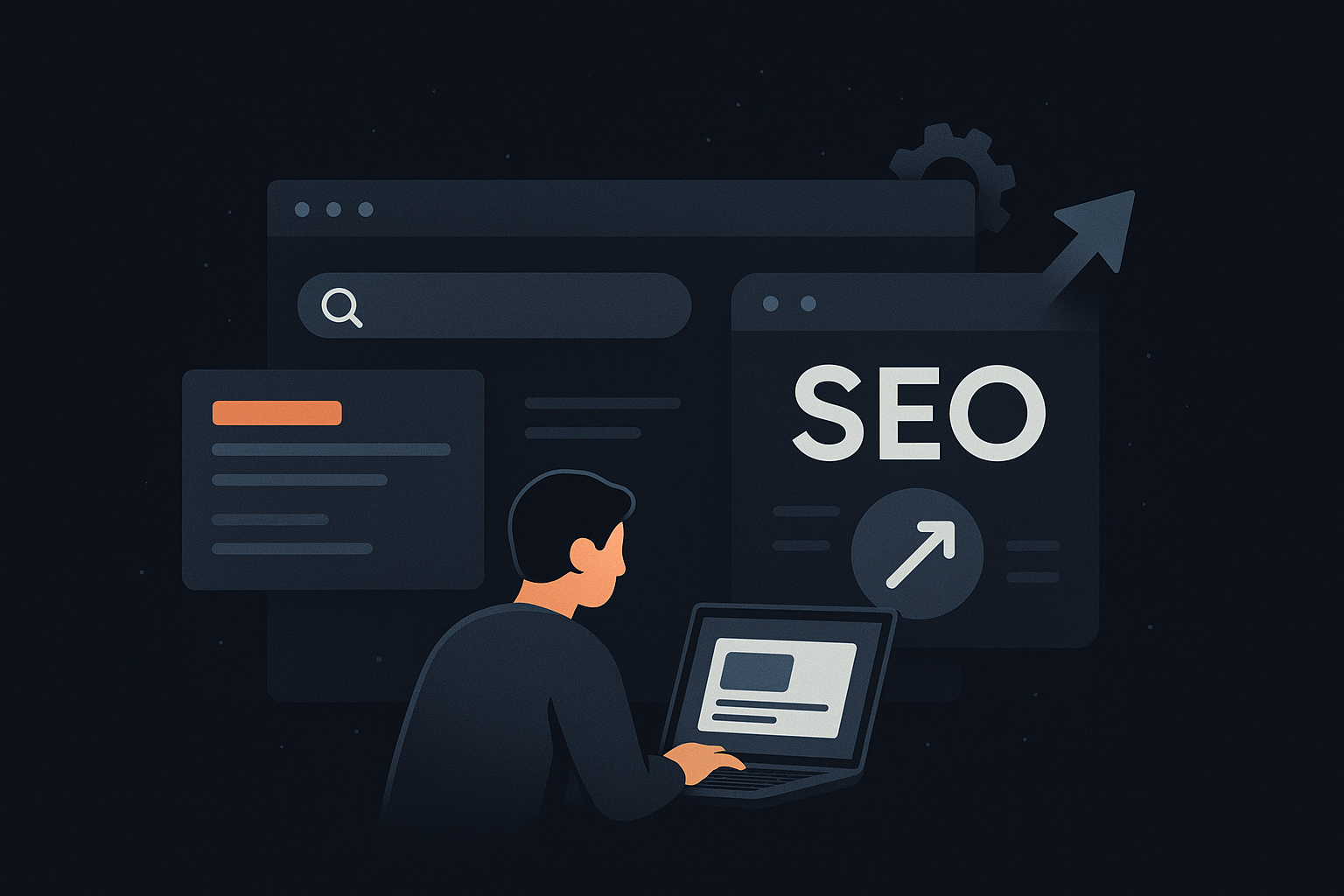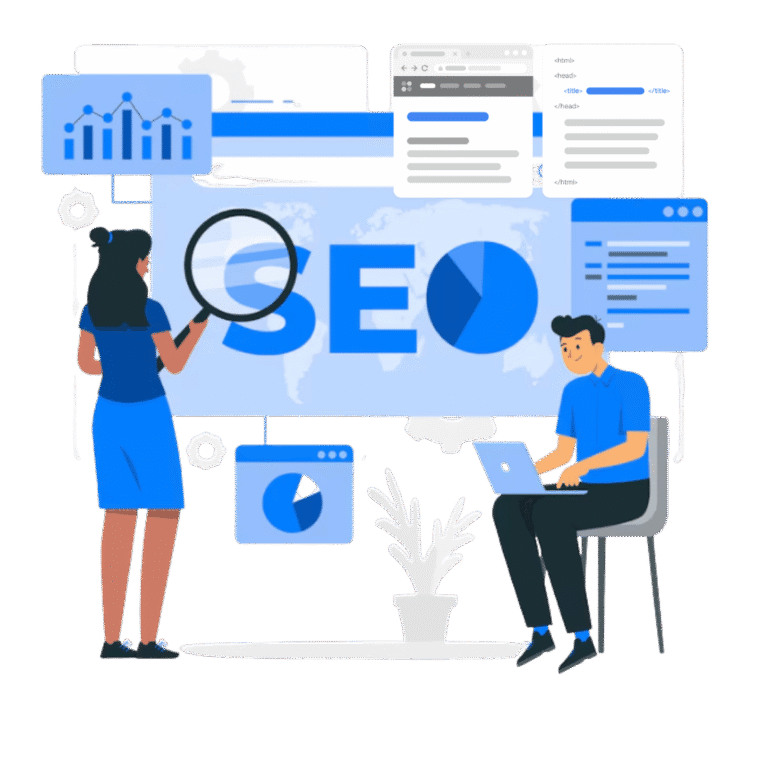Drive More Traffic. Rank Higher. Win More Customers.
Boost Rankings & Visibility With SEO Services
Dominate search results, attract ready-to-buy customers, and grow your revenue with proven, data-driven SEO strategies. We deliver faster rankings, measurable results, and sustainable visibility — all backed by a dedicated account manager who works closely with you to plan, create, and implement winning campaigns tailored to your business goals.
why SEO matters more than ever!

Drive More Traffic. Rank Higher. Win More Customers.
Maximize Your Website SEO to Dominate Every Search
Whether you’re targeting local or global markets, we leverage industry-leading tools and proven strategies to boost your visibility on Google. Our focus is on ranking high-intent keywords that actually convert. Unlike paid ads, SEO delivers organic traffic that compounds over time—reducing cost-per-acquisition and driving sustainable growth. Our SEO strategy zeroes in on the key factors that will elevate your organic visibility, traffic, and conversions.
Our SEO Process
We understand exactly what search engine algorithms and LLM’s look for, and we’ve crafted a proven, data-driven process designed to boost your pages to the top of search results—and keep them there.
Technical SEO is the backbone of your website’s organic search performance.
No matter how valuable or engaging your content is, it won’t rank if search engine bots can’t properly find, crawl, and understand it. By implementing our proven technical SEO strategies, we ensure your site is:
EASILY CRAWLABLE
Search engine bots (Googlebot, Bingbot, etc.) can move through and read your site without running into obstacles.
Key points:
- Website has a clear internal linking structure so bots can follow links to all important pages.
- No important pages are blocked in
robots.txt. - Navigation menus and links are in HTML (not hidden inside scripts search engines can’t read).
- URLs are clean and descriptive, without excessive parameters.
Common issues that hurt crawlability:
- Blocking key pages or folders in
robots.txt. - Broken internal links (404 errors).
- Heavy reliance on JavaScript navigation without proper fallback HTML links.
- Orphan pages (no other page links to them).

FULLY INDEXABLE
When website pages once crawled, your pages are actually stored in the search engine’s database and can show up in search results.
Key points:
- Pages do not have a
noindextag unless intentionally excluded. - Content is unique and not duplicate of other pages.
- Server returns a proper
200 OKstatus (not404or301loops). - Schema markup and metadata help search engines understand the content.
Common issues that hurt indexability:
noindexmeta tags on important pages.- Duplicate content without canonical tags.
- Pages blocked by password or login walls.
- Slow or error-prone servers causing Google to skip indexing.

MOBILE-OPTIMIZED
Your website must be designed and optimized to work seamlessly on smartphones and tablets.
Key points:
- Responsive design that adapts to different screen sizes.
- Text is readable without zooming.
- Buttons and links are tap-friendly (spaced well apart).
- Fast loading speed on mobile connections.
Common issues that hurt mobile friendliness:
- Desktop-only design that forces horizontal scrolling on mobile.
- Small text and unclickable buttons.
- Pop-ups or interstitials covering the screen.
- Large uncompressed images slowing down load time.

When your site’s technical foundation is solid, search engines can accurately interpret your content, increasing the chances of higher rankings and better visibility.
Keyword Research: Target the Terms That Drive Conversions
Strategic keyword research ensures your content matches exactly what your audience is searching for. We focus on:
Search Intent Analysis
Understand what users truly want so your content directly satisfies their needs.
Key points:
- Identify whether a search query is informational, navigational, or transactional.
- Study SERP features (featured snippets, shopping results, videos) to see how Google interprets intent.
- Compare top-ranking pages to find common content types and formats for that intent.
- Adjust your content to align with both user expectations and search engine signals.

High-Volume Keyword Targeting
Capture broad audience interest and drive traffic growth through popular search terms.
Key points:
- Target keywords with high search volume but manageable competition.
- Create comprehensive pillar pages that cover these topics in depth.
- Use internal linking to funnel traffic from these high-traffic pages to conversion-focused ones.
- Monitor performance to ensure traffic quality, not just quantity.

Long-Tail Keyword Discovery
Find niche search terms with strong purchase or conversion intent.
Key points:
- Target phrases of 3+ words that indicate specific needs.
- Often have lower competition, making them easier to rank for.
- Attract highly qualified leads ready to take action.
- Use search suggestions, People Also Ask, and related searches for ideas.

Paid Search Data Integration
Leverage PPC insights to uncover high-converting keywords for SEO.
Key points:
- Analyze Google Ads or Meta Ads data to find terms with the highest conversion rates.
- Identify which ad copy or landing pages perform best for these keywords.
- Use paid search click-through rate (CTR) data to refine organic titles and descriptions.
- Prioritize keywords where paid results show strong ROI for organic targeting.

This ensures you rank for the keywords most likely to convert visitors into leads and customers.
Competitive Analysis: Outsmart and Outrank Your Rivals
A deep dive into your competitors’ SEO strategies reveals the exact steps needed to overtake them in search rankings. We focus on:
Competitive Keyword Intelligence
Identify high-value keywords your competitors target and uncover untapped keyword opportunities.
Key points:
- Research competitor keyword rankings to see which terms drive their traffic.
- Find high search volume, low competition keywords they haven’t targeted.
- Analyze keyword intent (informational, navigational, transactional) to prioritize the right audience.
- Use keyword gap analysis tools to compare your keywords vs. theirs.
Common uses:
- Building new landing pages for high-intent keywords.
- Expanding blog content around trending topics in your niche.
- Improving existing pages to target missed keyword variations.

Content Strategy Insights
Analyze your competitors’ top-performing topics, formats, and engagement drivers.
Key points:
- Review which blog posts, videos, or guides get the most backlinks and shares.
- Identify content formats that work best for their audience (e.g., how-to guides, listicles, infographics).
- Study their publishing frequency and content length for patterns.
- Check which CTAs and internal linking tactics they use to keep visitors engaged.
Common uses:
- Modeling successful content types with your unique spin.
- Filling gaps in your own content calendar.
- Refining on-page elements like headlines, images, and CTAs.

Competitor Backlink Profile Review
Uncover your competitors’ strongest links and find link-building opportunities they’ve missed.
Key points:
- Identify top referring domains that link to their site.
- Analyze anchor text diversity and relevance.
- Spot industry blogs, directories, or partners you could also pitch.
- Find broken backlinks pointing to them that you could reclaim.
Common uses:
- Creating targeted outreach lists for link acquisition.
- Strengthening domain authority through quality backlinks.
- Building relationships with industry influencers who already link to competitors.

Gap & Opportunity Mapping
Pinpoint weaknesses in competitor strategies and turn them into ranking advantages.
Key points:
- Identify missing content topics they haven’t covered.
- Find keyword rankings where they’re on page 2 or 3 and you can outrank them.
- Analyze under-optimized pages that can be outperformed with better content.
Common uses:
- Launching targeted campaigns where competition is weak.
- Prioritizing quick-win opportunities in SEO.
- Building a roadmap that turns competitor weaknesses into your strengths.

With this intelligence, you get a clear, data-driven action plan to gain the upper hand in SERPs.
TEMPLATE OPTIMIZATION: SCALE SEO BEST PRACTICES ACROSS YOUR SITE
For websites with extensive content, template optimization delivers a major SEO advantage by ensuring consistency and efficiency at scale. We focus on:
Scalable SEO Implementation
Apply proven SEO best practices across hundreds or thousands of pages at once.
Key points:
- Standardize URL structures, heading formats, and internal linking across all pages.
- Ensure site-wide technical settings like canonical tags and structured data are correctly applied.
- Avoid manual, page-by-page updates that slow down large-scale optimization.

Dynamic Content Insertion
Automatically populate page elements with relevant, targeted keywords.
Key points:
- Pull keywords dynamically from product names, categories, or database fields.
- Auto-generate SEO-friendly titles, H1 headings, and meta descriptions at scale.
- Reduce duplication by combining static and dynamic text in metadata.
- Maintain flexibility so keywords can be updated centrally without touching each page.

Consistent SEO Elements
Maintain a uniform optimization structure across all templates for stronger search signals.
Key points:
- Use consistent title formats, meta descriptions, heading hierarchies, and structured data.
- Apply the same schema markup standards across all relevant page types.
- Ensure internal linking patterns remain logical and consistent.
- Keep keyword targeting aligned across similar content types to build topical authority.

This approach ensures every page meets SEO standards without sacrificing time or quality.
SEO MIGRATIONS: PROTECT RANKINGS DURING SITE TRANSITIONS
A poorly planned migration can cost you traffic, rankings, and valuable backlinks. We ensure your move is search-engine friendly by focusing on:
URL Mapping & Redirects
Maintain SEO performance during migration by ensuring every old URL points to the correct new page. Accurate 301 redirects help preserve link equity and prevent user drop-offs.
Key points:
- Create a detailed URL mapping document before migration.
- Implement 301 redirects from old URLs to their corresponding new URLs.
- Test all redirects to confirm they work correctly.
- Avoid redirect chains and loops that can slow down page load and hurt rankings.

Backlink Preservation
Protect the authority and trust signals your site has earned over time by carrying forward valuable backlinks.
Key points:
- Identify all high-value backlinks using SEO tools
- Ensure linked pages are redirected to equivalent new content.
- Update partners or referring sites if their backlinks point to outdated URLs.
- Monitor for lost backlinks and reclaim them quickly.

Post-Migration Monitoring
Track and analyze your SEO performance immediately after the migration to catch issues early.
Key points:
- Monitor keyword rankings daily for significant drops.
- Check Google Search Console for crawl errors or warnings.
- Track organic traffic trends in Google Analytics.
- Quickly fix broken links, missing meta tags, or indexing issues.

Technical SEO Checks
Ensure the technical foundation of your site remains strong post-migration to maintain rankings and performance.
Key points:
- Audit indexing status and confirm important pages are included.
- Verify XML sitemap and robots.txt are updated and correct.
- Check site speed and Core Web Vitals.
Ensure meta tags, schema markup, and canonical tags are preserved.

A well-planned SEO migration not only safeguards visibility—it can also strengthen your site’s technical foundation for future growth.

GET THE BASIC SEO OPTIMIZATION
Affordable SEO Essentials for Better Ranking Better Optimization
Perfect for small businesses or websites on a budget, this service covers the core SEO tasks that make the biggest impact—without the full-scale strategy cost. We focus on:
- Writing keyword-optimized meta titles and descriptions for all pages.
- Organizing H1, H2, and H3 tags for clarity and SEO strength.
- Connecting pages for better navigation and indexing.
- Adding alt tags and compress images for faster loading.
- Naturally integrating target keywords for improved visibility.
- Adding Sitemap of your webiste to google search console for faster indexing
Low cost, high impact — this optimization is ideal for quickly improving search performance without committing to a full-scale SEO campaign.
Technical SEO is the backbone of your website’s organic search performance.
No matter how valuable or engaging your content is, it won’t rank if search engine bots can’t properly find, crawl, and understand it.
By implementing our proven technical SEO strategies, we ensure your site is:
- EASILY CRAWLABLE– so search engines can discover all your pages
- FULLY INDEXABLE – so your content appears in relevant search results
- MOBILE FRIENDLY – to meet Google’s mobile-first indexing requirements
When your site’s technical foundation is solid, search engines can accurately interpret your content, increasing the chances of higher rankings and better visibility.
Competitive Analysis: Outsmart and Outrank Your Rivals
A deep dive into your competitors’ SEO strategies reveals the exact steps needed to overtake them in search rankings. We focus on:
- KEYWORD INTELLIGENCE – Identify high-value keywords your competitors target and discover untapped opportunities.
- CONTENT STRATEGY INSIGHTS – Analyze their top-performing topics, formats, and engagement drivers.
- BACLINK PROFILE REVIEW – Uncover their strongest links and find link-building opportunities they’ve missed.
- GAP & OPPORTUNITY MAPPING – Pinpoint weaknesses in their strategy you can turn into ranking advantages.
With this intelligence, you get a clear, data-driven action plan to gain the upper hand in SERPs.
Keyword Research: Target the Terms That Drive Conversions
Strategic keyword research ensures your content matches exactly what your audience is searching for. We focus on:
- SEARCH INTENT ANALYSIS – Understand what users really want so your content meets their needs.
- HIGH-VOLUME KEYWORD TARGETING – Capture broad audience interest for traffic growth.
- LONG-TAIL KEYWORD DISCOVERY – Find niche terms with strong purchase intent.
- PAID SEARCH DATA INTEGRATION – Use PPC insights to uncover high-converting keywords.
- ORGANIC & PAID SYNERGY – Combine data to reveal overlooked ranking opportunities.
This ensures you rank for the keywords most likely to convert visitors into leads and customers.
TEMPLATE OPTIMIZATION: SCALE SEO BEST PRACTICES ACROSS YOUR SITE
For websites with extensive content, template optimization delivers a major SEO advantage by ensuring consistency and efficiency at scale. We focus on:
- SCALABLE SEO IMPLEMENTATION – Apply best practices across hundreds or thousands of pages instantly.
- DYNAMIC CONTENT INSERTION – Automatically populate titles, headings, and meta descriptions with relevant keywords.
- CONSISTENT SEO ELEMENTS – Maintain uniform optimization across all templates for stronger search signals.
- TIME & RESOURCE EFFICIENCY – Reduce manual work while ensuring every page is SEO-ready.
This approach ensures every page meets SEO standards without sacrificing time or quality.
SEO MIGRATIONS: PROTECT RANKINGS DURING SITE TRANSITIONS
A poorly planned migration can cost you traffic, rankings, and valuable backlinks. We ensure your move is search-engine friendly by focusing on:
- URL MAPPING & REDIRECTS – Preserve link equity and avoid broken pages with accurate 301 redirects.
- BACKLINK PRESERVATION – Protect and carry over the authority you’ve built over time.
- POST-MIGRATION MONITORING – Track rankings, traffic, and errors to quickly resolve any issues.
- TECHNICAL SEO CHECKS – Ensure indexing, crawlability, and speed aren’t compromised during the transition.
A well-planned SEO migration not only safeguards visibility—it can also strengthen your site’s technical foundation for future growth.
Our Clients




